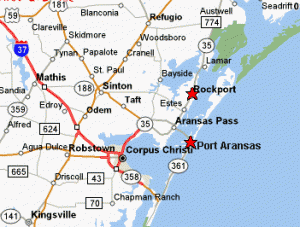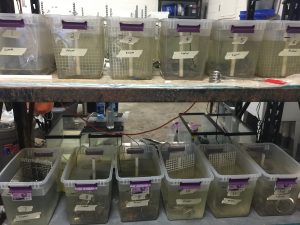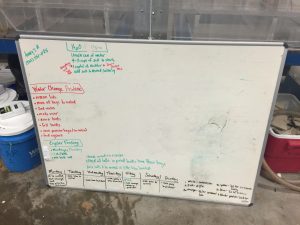Author(s)
Introduction
My ETEAMS research experience was with associate professor Dr. Lee Smee and graduate student Avery Scherer at Texas A&M Corpus Christi University. This summer’s research is a continuation of previous experiment conducted. Avery’s research focuses on oyster reefs and their importance in a marine ecosystem. Oyster Reefs are filter feeders and feed on phytoplankton which helps water quality. Restoration of Oyster Reefs is imperative due to their cornerstone role in many reef habitats. Avery’s specific question was if the oysters’ shells were thickened in the presence of predators.
Oyster reef, Port Aransas, Texas located on South Padre Island.
Map of the Gulf Coast
Same Oyster Reef, with water level receded.
Methods & Procedures
The oysters used in the experiment are ordered as seeds and placed into small cages and put into salt water. The experiment consisted of pairs of water tanks one a control and the other with a predator present. The predator of choice was the blue crab. Each cage of oysters was given a colored zip tie that identified the amount of time they would spend in the tanks with the predator. The independent variables being tested were the amount of time spent with a predator either consecutively or broken up. The dependent variable was the thickness or growth of the oyster shells. The decision to use oyster seed over spat was made after difficulties keeping the oysters alive in the previous summer’s experiment.
Colors of zip ties with corresponding time spent with predators:
Yellow- 72 consecutive hours with predator, early in week
Orange- 72 consecutive hours with predator, late in week
Pink- 24 hours with predator
Blue- 72 hours with predator, broken up (day on, day off)
Black- 168 hours consecutive with predator
Each of the tanks has a bubbler to keep the salt water oxygenated so the blue crabs and oyster seed may flourish. Also a grate was placed in front of the oyster cages so the blue crabs did not destroy them. Even with the grates the crabs still managed to damage the oyster cages.
Each control tank was paired with a predator tank pictured here.
Board detailing schedule on when each cage of oysters was to be moved. Also instructions on water change schedule.
Each tank must have a water change every week. The water changes consists of draining each tank, mixing gallons of water with salt to create new fresh water and refilling the tanks. The tanks are filled with water that is poured into a large garbage can. After, five scoops of salt are added to create new salt water. Before filling the tanks, a refractometer is used to test the salinity of the water. If the water is too salty or not enough it could compromise the whole experiment.
Results
The nature of the experiment does not allow for much data to be taken as it is in progress and is dependent on its data at the end of the given time. For this experiment results will not become available until October. However, Avery does expect that oysters that have spent the most time with the predators will have formed the thickest oyster shell.
Discussion
This experiment was important to conduct in order for us to better understand how oyster reefs work. The knowledge gained from this experiment will help others become better conservationists. Destruction of natural habitats in marine environments is becoming a bigger issue everyday. Teaching students about what the oyster reefs provide and how they are integral to marine environments will hopefully create more aware population that will begin to fix the damage done to natural habitats. Furthermore, students should be aware of their local community that surrounds them and how they effect it. Overall, this experience has been rewarding, educational and will allow me to become a more well-rounded teacher in the classroom.
Lesson Plan
Mystery of Oyster Reefs
Engage:
Students will watch video to give them a background of Oyster Reefs and their importance to the environment.
Show class YouTube video of “Amazing Oyster Reef.” https://www.youtube.com/watch?v=PbFQ5EndLso
Questions following the video:
What did the video point to as to why oyster reefs are important?
What problems do shipping industries present to the oyster reefs?
How do oyster reefs help other marine species?
Why are oyster reef barriers more beneficial than man-made?
Explore:
Students will use http://estuaries.noaa.gov/ScienceData/Graphing.aspx, with the teacher to explore estuary education site. Specifically the tool that can find things like turbidity, pH levels, and water quality over a certain amount of time.
Vocabulary students might not know:
Turbidity: the cloudiness, or opaqueness of water (i.e murky or clear)
pH: a scale on which liquids are determined basic or acidic
salinity: how much salt can be found in the water
Questions:
What do you think can effect turbidity?
How do you think oyster harm/help turbidity?
Explain:
Teacher will show students an informative PPT and give students answers to the questions being posed in the first activities. PPT: Oyster Reefs
Teacher will foster any additional student may have about the PPT and give clarity to how oysters benefit the ecosystem.
Elaborate:
Students will be paired as a team. The assignment is to take the new knowledge of how species can be interdependent on one another and find a different example in nature. Students can use the allotted computer lab to do research.
Vocabulary:
Mutualism- a relationship that is beneficial to both organisms.
Parasitism-a relationship that is only beneficial to one of the organisms. (ex. Ticks and Dogs)
Predator/Prey- a relationship in which one organisms is dependent on the presence of the other for a food source. (ex. Cheetah and Zebra)
Evaluate:
Students will present their findings to their classmates with a poster board. Students will first have a draft that their peers may evaluate with sticky note giving critique and questions. Students will then revise and re-present their project.
TEKS, 8th grade Science
11) Organisms and environments. The student knows that interdependence occurs among living systems and the environment and that human activities can affect these systems. The student is expected to:
(A) describe producer/consumer, predator/prey, and parasite/host relationships as they occur in food webs within marine, freshwater, and terrestrial ecosystems;
(B) investigate how organisms and populations in an ecosystem depend on and may compete for biotic and abiotic factors such as quantity of light, water, range of temperatures, or soil composition;
(C) explore how short- and long-term environmental changes affect organisms and traits in subsequent populations; and
(D) recognize human dependence on ocean systems and explain how human activities such as runoff, artificial reefs, or use of resources have modified these systems.




